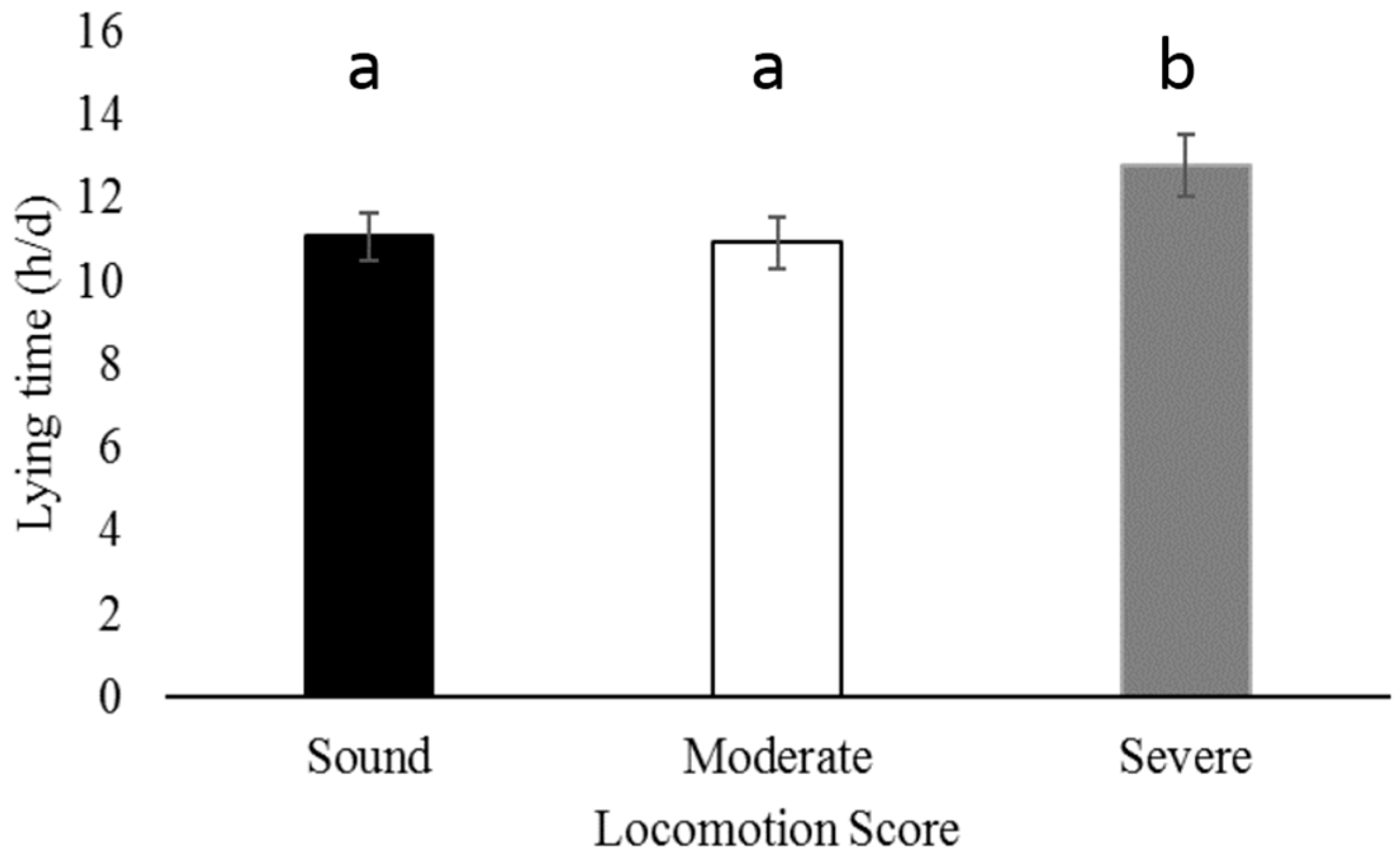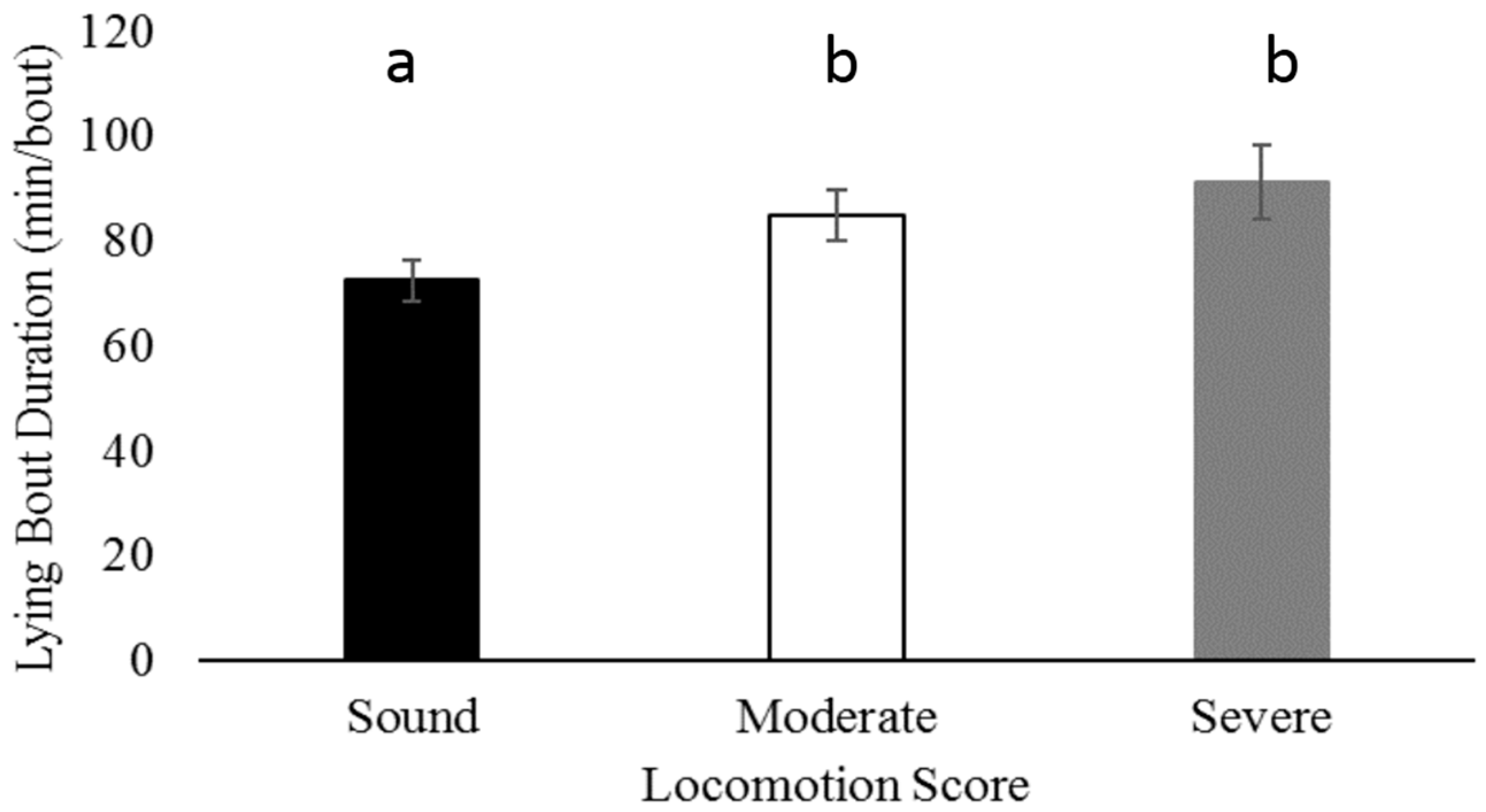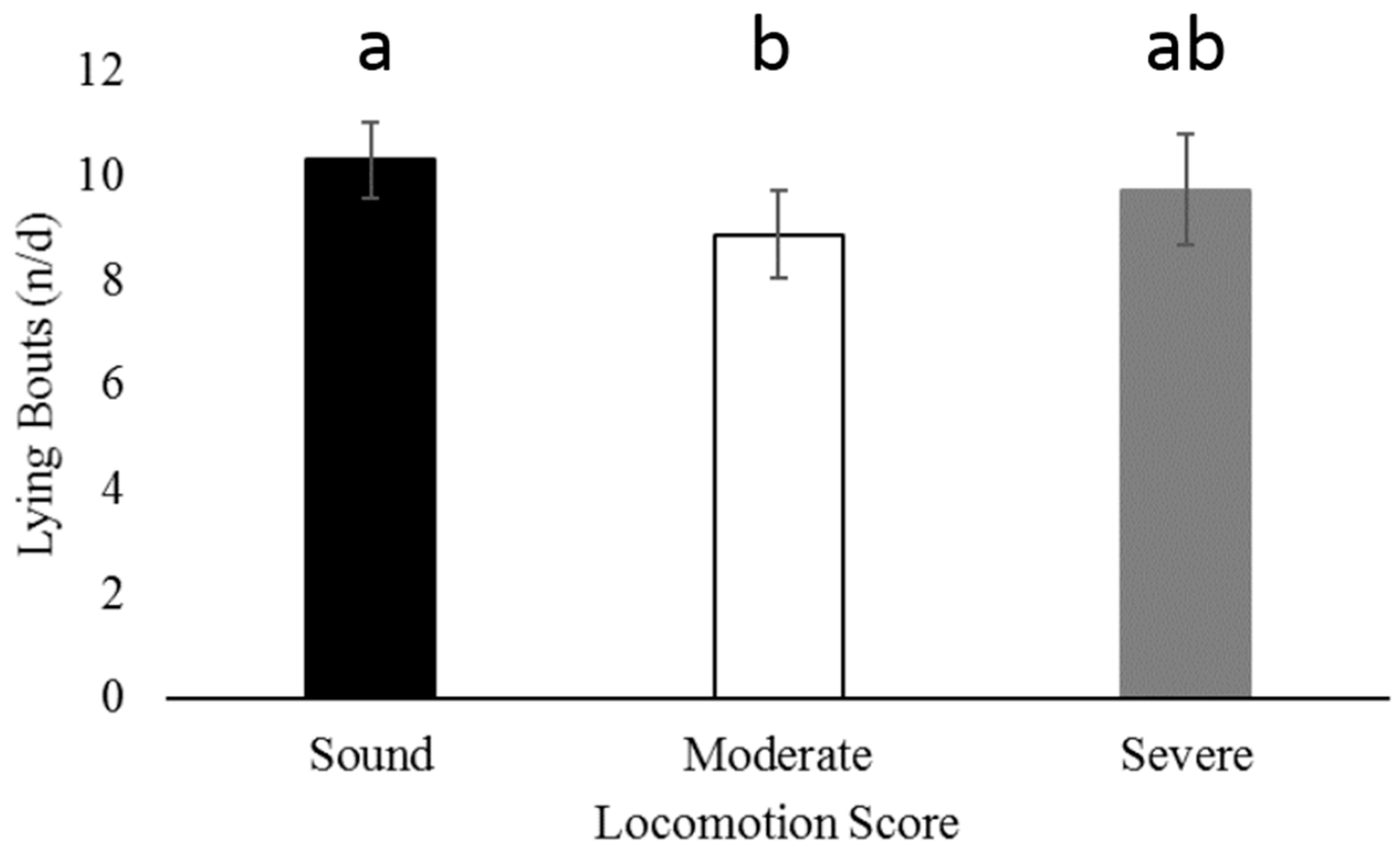The Effect of Hock Injury Laterality and Lameness on Lying Behaviors and Lying Laterality in Holstein Dairy Cows
Abstract
:Simple Summary
Abstract
1. Introduction
2. Materials and Methods
3. Results
4. Discussion
5. Conclusions
Acknowledgments
Author Contributions
Conflicts of Interest
References
- Weary, D.M.; Taszkun, I. Hock lesions and free-stall design. J. Dairy Sci. 2000, 83, 697–702. [Google Scholar] [CrossRef]
- Von Keyserlingk, M.A.G.; Barrientos, A.; Ito, K.; Galo, E.; Weary, D.M. Benchmarking cow comfort on north american freestall dairies: Lameness, leg injuries, lying time, facility design, and management for high-producing holstein dairy cows. J. Dairy Sci. 2012, 95, 7399–7408. [Google Scholar] [CrossRef] [PubMed]
- Klaas, I.C.; Rousing, T.; Fossing, C.; Hindhede, J.; Sorensen, J.T. Is lameness a welfare problem in dairy farms with automatic milking systems? Anim. Welf. 2003, 12, 599–603. [Google Scholar]
- Kester, E.; Holzhauer, M.; Frankena, K. A descriptive review of the prevalence and risk factors of hock lesions in dairy cows. Vet. J. 2014, 202, 222–228. [Google Scholar] [CrossRef] [PubMed]
- Chapinal, N.; de Passille, A.M.; Rushen, J.; Wagner, S. Automated methods for detecting lameness and measuring analgesia in dairy cattle. J. Dairy Sci. 2010, 93, 2007–2013. [Google Scholar] [CrossRef] [PubMed]
- Brenninkmeyer, C.; Dippel, S.; Brinkmann, J.; March, S.; Winckler, C.; Knierim, U. Hock lesion epidemiology in cubicle housed dairy cows across two breeds, farming systems and countries. Prev. Vet. Med. 2013, 109, 236–245. [Google Scholar] [CrossRef] [PubMed]
- United States Department of Agriculture. Dairy 2007, Part IV: Reference of Dairy Cattle Health and Management Practices in the United States, 2007; USDA: Washington, DC, USA, 2009.
- Haskell, M.J.; Rennie, L.J.; Bowell, V.A.; Bell, M.J.; Lawrence, A.B. Housing system, milk production, and zero-grazing effects on lameness and leg injury in dairy cows. J. Dairy Sci. 2006, 89, 4259–4266. [Google Scholar] [CrossRef]
- Dippel, S.; Dolezal, M.; Brenninkmeyer, C.; Brinkmann, J.; March, S.; Knierim, U.; Winckler, C. Risk factors for lameness in freestall-housed dairy cows across two breeds, farming systems, and countries. J. Dairy Sci. 2009, 92, 5476–5486. [Google Scholar] [CrossRef] [PubMed]
- Ito, K.; von Keyserlingk, M.A.G.; LeBlanc, S.J.; Weary, D.M. Lying behavior as an indicator of lameness in dairy cows. J. Dairy Sci. 2010, 93, 3553–3560. [Google Scholar] [CrossRef] [PubMed]
- Solano, L.; Barkema, H.W.; Pajor, E.A.; Mason, S.; LeBlanc, S.J.; Nash, C.G.R.; Haley, D.B.; Pellerin, D.; Rushen, J.; de Passille, A.M.; et al. Associations between lying behavior and lameness in canadian holstein-friesian cows housed in freestall barns. J. Dairy Sci. 2016, 99, 2086–2101. [Google Scholar] [CrossRef] [PubMed]
- Drissler, M.; Gaworski, M.; Tucker, C.B.; Weary, D.M. Freestall maintenance: Effects on lying behavior of dairy cattle. J. Dairy Sci. 2005, 88, 2381–2387. [Google Scholar] [CrossRef]
- Krawczel, P.D.; Klaiber, L.B.; Butzler, R.E.; Klaiber, L.M.; Dann, H.M.; Mooney, C.S.; Grant, R.J. Short-term increases in stocking density affect the lying and social behavior, but not the productivity, of lactating holstein dairy cows. J. Dairy Sci. 2012, 95, 4298–4308. [Google Scholar] [CrossRef] [PubMed]
- Bao, J.; Giller, P.S. Observations on the changes in behavioral activities of dairy cows prior to and after parturition. Irish Vet. J. 1991, 44, 43–47. [Google Scholar]
- Forsberg, A.M.; Pettersson, G.; Ljungberg, T.; Svennersten-Sjaunja, K. A brief note about cow lying behaviour—Do cows choose left and right lying side equally? Appl. Anim. Behav. Sci. 2008, 114, 32–36. [Google Scholar] [CrossRef]
- Grant, R.J.; Colenbrander, V.F.; Albright, J.L. Effect of particle-size of forage and rumen cannulation upon chewing activity and laterality in dairy-cows. J. Dairy Sci. 1990, 73, 3158–3164. [Google Scholar] [CrossRef]
- Tucker, C.B.; Cox, N.R.; Weary, D.M.; Spinka, M. Laterality of lying behaviour in dairy cattle. Appl. Anim. Behav. Sci. 2009, 120, 125–131. [Google Scholar] [CrossRef]
- Yunta, C.; Guasch, I.; Bach, A. Short communication: Lying behavior of lactating dairy cows is influenced by lameness especially around feeding time. J. Dairy Sci. 2012, 95, 6546–6549. [Google Scholar] [CrossRef] [PubMed]
- Westin, R.; Vaughan, A.; de Passille, A.M.; De Vries, T.J.; Pajor, E.A.; Pellerin, D.; Siegford, J.M.; Vasseur, E.; Rushen, J. Lying times of lactating cows on dairy farms with automatic milking systems and the relation to lameness, leg lesions, and body condition score. J. Dairy Sci. 2016, 99, 551–561. [Google Scholar] [CrossRef] [PubMed]
- Bewley, J.M.; Taraba, J.; Day, G.; Black, R.A.; Damasceno, F. Virtual Guide to Compost Bedded Pack Barn Design & Management; Penn State College of Agricultural Sciences: University Park, PA, USA, 2012; p. 50. [Google Scholar]
- Ledgerwood, D.N.; Winckler, C.; Tucker, C.B. Evaluation of data loggers, sampling intervals, and editing techniques for measuring the lying behavior of dairy cattle. J. Dairy Sci. 2010, 93, 5129–5139. [Google Scholar] [CrossRef] [PubMed]
- University of British Columbia Animal Welfare Program. UBC Animal Welfare Program: Sop-Hobo Data Loggers; University of British Columbia: Vancouver, BC, Canada, 2013; pp. 1–23. [Google Scholar]
- National Animal Health Monitoring System (NAHMS). Nahms Lameness Detection Video. Available online: https://www.youtube.com/watch?v=3bOpSrowaJA (accessed on 3 March 2016).
- Fulwider, W.K.; Grandin, T.; Garrick, D.J.; Engle, T.E.; Lamm, W.D.; Dalsted, N.L.; Rollin, B.E. Influence of free-stall base on tarsal joint lesions and hygiene in dairy cows. J. Dairy Sci. 2007, 90, 3559–3566. [Google Scholar] [CrossRef] [PubMed]
- Vasseur, E.; Rushen, J.; Haley, D.B.; de Passille, A.M. Sampling cows to assess lying time for on-farm animal welfare assessment. J. Dairy Sci. 2012, 95, 4968–4977. [Google Scholar] [CrossRef] [PubMed]
- Jensen, M.B.; Pedersen, L.J.; Munksgaard, L. The effect of reward duration on demand functions for rest in dairy heifers and lying requirements as measured by demand functions. Appl. Anim. Behav. Sci. 2005, 90, 207–217. [Google Scholar] [CrossRef]
- Munksgaard, L.; Jensen, M.B.; Pedersen, L.J.; Hansen, S.W.; Matthews, L. Quantifying behavioural priorities-effects of time constraints on behaviour of dairy cows, bos taurus. Appl. Anim. Behav. Sci. 2005, 92, 3–14. [Google Scholar] [CrossRef]
- Cook, N.B.; Nordlund, K.V. The influence of the environment on dairy cow behavior, claw health and herd lameness dynamics. Vet. J. 2009, 179, 360–369. [Google Scholar] [CrossRef] [PubMed]
- Whay, H.R.; Waterman, A.E.; Webster, A.J.F.; O’Brien, J.K. The influence of lesion type on the duration of hyperalgesia associated with hindlimb lameness in dairy cattle. Vet. J. 1998, 156, 23–29. [Google Scholar] [CrossRef]
- Arave, C.W.; Walters, J.L. Factors affecting lying behavior and stall utilization of dairy-cattle. Appl. Anim. Ethol. 1980, 6, 369–376. [Google Scholar] [CrossRef]
- Ito, K.; Weary, D.M.; von Keyserlingk, M.A.G. Lying behavior: Assessing within- and between-herd variation in free-stall-housed dairy cows. J. Dairy Sci. 2009, 92, 4412–4420. [Google Scholar] [CrossRef] [PubMed]
- Ito, K.; Chapinal, N.; Weary, D.M.; von Keyserlingk, M.A.G. Associations between herd-level factors and lying behavior of freestall-housed dairy cows. J. Dairy Sci. 2014, 97, 2081–2089. [Google Scholar] [CrossRef] [PubMed]



| Variable | Farm 1 | Farm 2 | Farm 3 | Farm 4 | Overall |
|---|---|---|---|---|---|
| Cows | 32 | 61 | 42 | 60 | 195 |
| Sound | 19 | 42 | 25 | 31 | 117 |
| Moderately lame | 9 | 18 | 14 | 20 | 61 |
| Severely lame | 4 | 1 | 3 | 9 | 17 |
| Hock score 0 | |||||
| Left hock | 0 | 15 | 0 | 31 | 46 |
| Right hock | 0 | 14 | 0 | 31 | 45 |
| Hock score 1 | |||||
| Left hock | 15 | 37 | 23 | 27 | 102 |
| Right hock | 17 | 38 | 25 | 28 | 108 |
| Hock score 2 | |||||
| Left hock | 16 | 6 | 18 | 2 | 42 |
| Right hock | 15 | 8 | 13 | 1 | 37 |
| Hock score 3 | |||||
| Left hock | 1 | 3 | 1 | 0 | 5 |
| Right hock | 0 | 1 | 4 | 0 | 5 |
| Bilateral | 32 | 41 | 42 | 27 | 142 |
| Unilateral | 0 | 11 | 0 | 4 | 15 |
| Neither | 0 | 9 | 0 | 29 | 38 |
| Multiparous | 0 | 39 | 30 | 53 | 122 |
| Primiparous | 32 | 22 | 12 | 7 | 73 |
| Early lactation | 4 | 36 | 6 | 16 | 62 |
| Mid lactation | 19 | 25 | 29 | 32 | 105 |
| Late lactation | 9 | 0 | 7 | 12 | 28 |
| Variable | Estimate | SE | R² | p Value |
|---|---|---|---|---|
| SD of lying time (h/d) | ||||
| Multiparous | 0.31 | 0.13 | 0.30 | 0.02 |
| SD of lying duration (min/bout) | ||||
| Bilateral injury | −14.41 | 4.44 | 0.07 | 0.001 |
| No injury | −17.86 | 4.99 | 0.07 | 0.0004 |
| Multiparous | 5.02 | 2.49 | 0.02 | 0.05 |
© 2017 by the authors. Licensee MDPI, Basel, Switzerland. This article is an open access article distributed under the terms and conditions of the Creative Commons Attribution (CC BY) license (http://creativecommons.org/licenses/by/4.0/).
Share and Cite
Eberhart, N.L.; Krawczel, P.D. The Effect of Hock Injury Laterality and Lameness on Lying Behaviors and Lying Laterality in Holstein Dairy Cows. Animals 2017, 7, 86. https://doi.org/10.3390/ani7110086
Eberhart NL, Krawczel PD. The Effect of Hock Injury Laterality and Lameness on Lying Behaviors and Lying Laterality in Holstein Dairy Cows. Animals. 2017; 7(11):86. https://doi.org/10.3390/ani7110086
Chicago/Turabian StyleEberhart, Nicole L., and Peter D. Krawczel. 2017. "The Effect of Hock Injury Laterality and Lameness on Lying Behaviors and Lying Laterality in Holstein Dairy Cows" Animals 7, no. 11: 86. https://doi.org/10.3390/ani7110086




